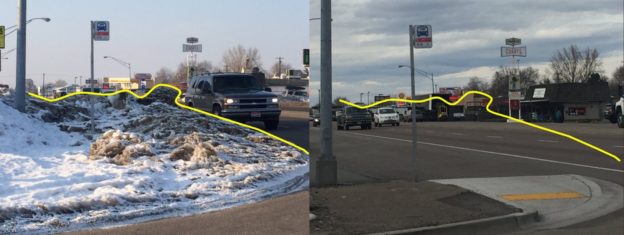By Don Kostelec
February 22, 2019
Public Works Directors shouldn’t dictate pedestrian safety. Yet, that’s what happens every winter when the snow flies.
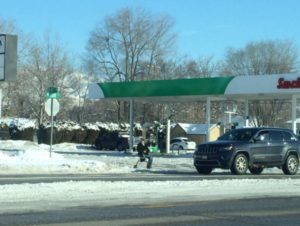
Plows are deployed. Snow is heaped onto sidewalks from the streets. And cities or DOTs wave their sidewalk policy at property owners, telling them to be a good neighbor and shovel their sidewalks.
If you quiz a public agency about why they purposely plow snow onto the sidewalks you’ll get these responses:
- Well, the snow has to go somewhere.
- We don’t have the money to clear sidewalks, too.
- We don’t do it on purpose.
- ¯\_(ツ)_/¯
My favorite is the City of Omaha Public Works: “Unfortunately, City Street crews will repeatedly plow and re-cover sidewalks. We apologize for the problem this creates but it is inevitable.”
Points for honesty.
Most agencies aren’t as forward in acknowledging exactly what they will and will not do when snow falls. They simply resort to comatose replies when you question them about it.
“Be a good neighbor,” says Omaha’s Public Works. “The good deed will be returned.”
Grunt and point at property owners. Salt the roads. Repeat.
Nevermind the fact that snow treated with salt or brine, then left to refreeze on sidewalks overnight, is impossible to remove with a shovel. It requires motorized equipment to remove.
Complete Streets Policies
The progress made on agencies adopting these policies over the past couple of decades is refreshing.
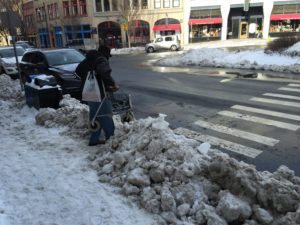
One of the common elements of a complete streets policies is use of phrases like all modes and all users of all ages and all abilities.
What’s missing? At all times.
This is where I think most of us would say the commitment to complete streets policies fall apart it comes to snow management and sidewalks, as well as bike lanes and pathways. Add an “at all times” clause to your city’s policy if it doesn’t have one.
An agency’s true commitment to complete streets is not found in its resolutions and plans; rather it’s found in its budget. If your winter complete streets budget consists of press releases and tweets begging for neighborliness, then you really don’t have a complete streets policy.
One of the best recent pieces written on this issue comes from Robin Mazumder in this post: “Sidewalk Snow Clearance is a Human Rights Issue.” In it, Mazumder writes:
- “People who are against city-sponsored snow clearance think that we can solve this problem through ‘neighborliness’. That, we can all just ‘chip in’ to ensure a universally accessible community. The reality is that many people just won’t shovel their sidewalks. Even if 99% of residents shoveled their sidewalks, the community would still be inaccessible.”
Heck, most agencies fail to enforce their own “neighborly” policies that require snow removal by property owners. Either they figure the demand would be too great if people knew they enforced it or elected officials would have a political nightmare on their hands if they tried to enforce it comprehensively.
If that’s not the greatest indicator that the problem must be addressed as Mazumder poses, then I don’t know what is.
Roads vs. Sidewalks
I presented on the topic of sidewalk snow management at the 2018 Montana Walk Bike Summit. The first question I asked the crowd was “Are you required to clear all of the travel lanes along a four- or six-lane road?” I got the usual confused puppy dog head tilts.
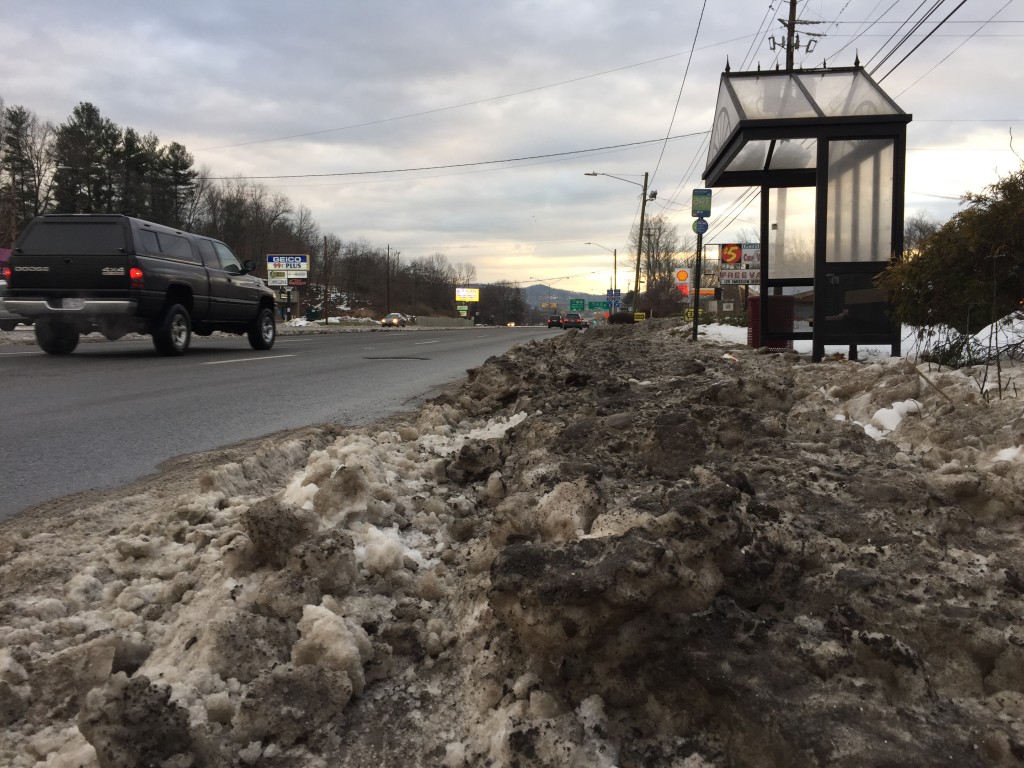
I pressed the group on it. Finally, I got an answer from a public works person, “Well, yes.”
Why?
They didn’t know why. And that tells me the approach agencies have to snow management is no more sophisticated than the recipe for making ice cubes.
Some time in the past someone decreed property owners should clear sidewalks and little thought has been applied since then.
I need to do the policy forensics on this, but my guess is property owner sidewalk policies emerged at a time when vehicular traffic volumes were low, as were speeds. Therefore, the thought of pedestrians operating in the street alongside a scattering of vehicles, some horse-drawn wagons, and bicyclists was not the threat to personal safety that it is today.
It was also long before attention was given and laws passed to recognize the needs of people with disabilities in that setting.
Policies have failed to evolve as high speed, high volume arterials have become the norm in cities. Much like agencies who take advantage of pedestrian right of way laws to design streets with long gaps between street crossing or crosswalks, they now design roads that further distance themselves from responsibility for sidewalk snow management.

Case in point: Why does an agency in a northern climate with snowfall have streets that lack a buffer between the sidewalk and curb? They know it snows. They know they need space for snow storage. Why is it acceptable to use the sidewalk for snow storage?
What if an agency plowed only two travel lanes on every four-lane surface street? What if they plowed only four travel lanes on six-lane streets?
Have they ever thought of that?
Oh, heck no.
Even as roadway lane miles have expanded greatly, my guess is there hasn’t been a second thought applied to whether or not agencies need to plow all of those lanes.
I suspect someone would come up with an emergency services justification and there’s probably some validity to that. But it would be easy to plow just enough space on a multi-lane road to allow other vehicles to pull to the side when emergency service vehicles needs to pass.
However, emergency service access can’t be all that important since many agencies do not plow residential streets (where almost everyone in a city lives) or they prioritize arterial roadways and eventually plow the residential streets when major roads are clear and dry.
Why not do the same for sidewalks? Define your sidewalk arteries. Plow them. This would encompass downtown streets, school walk routes, transit access routes, and major activity centers.
Manageable, Meaningful Solutions
Three years ago I wrote a detailed piece on a variety of snow management techniques for sidewalks. I was inspired by a long walk in the snow throughout Asheville, NC, as I saw plows purposely mounding snow against curb ramps, people having to climb over these mounds, and a foot of snow heaped by the state DOT onto bus stops along a six-lane arterial. You can read the full piece to get the details.
These are strategies that can be used in the throes of plowing operations, while more detailed work can come after.
- Plow with care, since slow plow speeds mean less mounding and heaping snow onto sidewalks.
- Define priority routes, as I mentioned above.
- Deploy smaller machines to clear bus stops and curb ramps after the larger plows come through.
- Clear the route from bus stops to curb ramps to allow for basic access.
Additionally, I posed two other over-arching policy solutions:
- Realign policies to reflect reality. I love the policy Pleasant Hill, Iowa, has for snow removal. Yes, they still put that duty on property owners but they specify that it applies to the “natural snow,” meaning the snow that falls from the sky rather than the snow that plows heap onto the sidewalks. In places with modest amounts of snowfall, that’s not an unreasonable expectation.
- Dedicate a % of snow management budget to sidewalks. There’s an easy metric to start with on this one: The percent of households without access to a vehicle. In Omaha, that’s 8.3% of the population. If Omaha’s annual snow management budget is $1 million, then put $83,000 to start with toward sidewalk snow management. If you reduce the speed of plows, thus reducing the amount of snow heaped onto sidewalks, then that money goes a lot farther. It’s motivation for plow operators to plow with care.
Agencies: Do What You’re Required to Do
As Robin Mazumber pointed out, sidewalk snow clearance is a human rights issue. In the United States, the Americans with Disabilities Act (ADA) is meant to guarantee that.
The property owner requirements for snow removal have been in place long before ADA was passed. Can you name other agency policies that were never modified or modernized after other Civil Rights Laws passed? Probably not. Yet the property owner responsibility relics remain.
When you dive into the details of ADA and how entities like the United States Access Board and Federal Highway Administration apply it, you get a mixed bag of directives. There’s some stern language in there, but they also punt on the issue.
FHWA’s Civil Rights division has the most definitive statement on the topic in its website on “Questions and Answers about ADA/Section 504”:
- “A public agency must maintain its walkways in an accessible condition, with only isolated or temporary interruptions in accessibility. 28 CFR §35.133. Part of this maintenance obligation includes reasonable snow removal efforts. (9-12-06)”
What’s “reasonable”? That’s probably one for courts to decide.
- “As part of maintenance operations, public agencies’ standards and practices must ensure that the day-to-day operations keep the path of travel on pedestrian facilities open and usable for persons with disabilities, throughout the year. This includes snow removal, as noted above, as well as debris removal, maintenance of accessible pedestrian walkways in work zones, and correction of other disruptions. ADAAG 4.1.1(4). Identified accessibility needs should be noted and incorporated into the transition plan. (9-12-06)”
In a 2008 memo FHWA noted a requirement to clear sidewalks that were built with federal funds.
- “Current maintenance provisions require pedestrian facilities built with Federal funds to be maintained in the same manner as other roadway assets.”
If you salt the road, you must salt the sidewalk. If you plow the road, you must plow the sidewalk. The next sentence acknowledges that some agencies limit plowing of some streets, which would not necessarily trip the requirement to treat the sidewalks. The policy reference in this also makes it a requirement to maintain bike lanes built with federal funds in the same manner as the adjacent automobile lanes.
Beyond that, even when agencies hide behind the property owner responsibility policy, they often neglect the federal requirements to keep curb ramp and crosswalk access clear. Per the US Access Board, curb ramps and crosswalks are considered “pedestrian access routes” and “pedestrian circulation routes.”
They define an Accessible Route as “a continuous unobstructed path connecting all accessible elements and spaces of a building or facility…Exterior accessible routes may include parking access aisles, curb ramps, crosswalks at vehicular ways, walks, ramps, and lifts. (ADAAG 3.5)”
Ramps and crosswalks are not sidewalks. Curb ramps are connections to sidewalks from the street. Crosswalks are fully contained in the curb-to-curb section of the roadway.
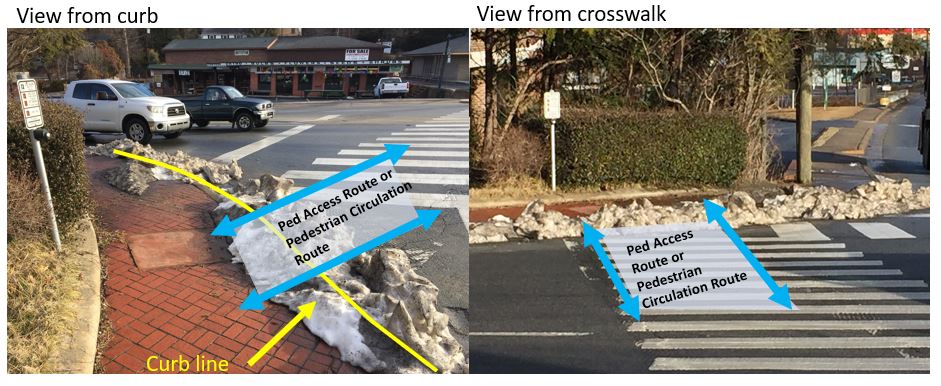
Yet, snow plow operations routinely block the interface between curb ramps and crosswalks, as well as medians and pedestrian refuge islands. They are required by law to keep those clear even if property owners have to clear sidewalks. They can’t deny that responsibility, but most do.
Use these policies to start the conversation in your community. They can’t wiggle their way out of these responsibilities. Hopefully that’s the jumping off point for more comprehensive plowing of sidewalks.

